The Red Gown and St Andrews
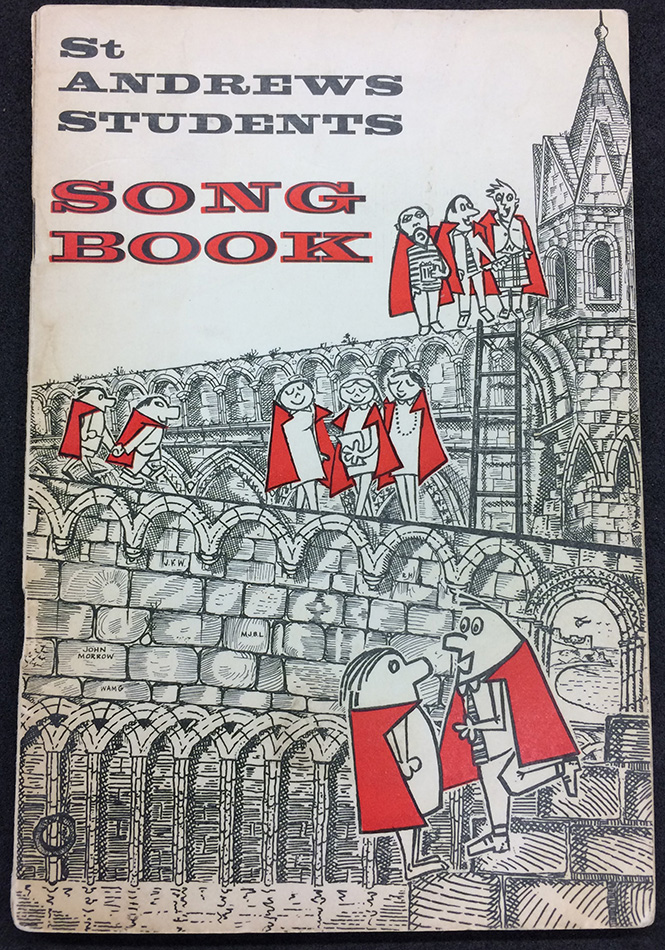
Echoes from the Vault has looked at a few of the University of St Andrews traditions in recent years – the May dip, Raisin Monday, orientation, matriculation, examinations, Rector’s Installation and graduation. One of the most well-known St Andrews student traditions is the wearing of the red gown. Worn by undergraduates to formal occasions, or by some all year round, the red gown, in the present day, has become synonymous with St Andrews.
The red gown however is not a tradition that is exclusive to St Andrews. The red or scarlet undergraduate gown was part of academic dress for many of the Scottish “ancient” universities, including Glasgow, Aberdeen and Edinburgh – although it fell out of use in most of these institutions in the early 20th century.
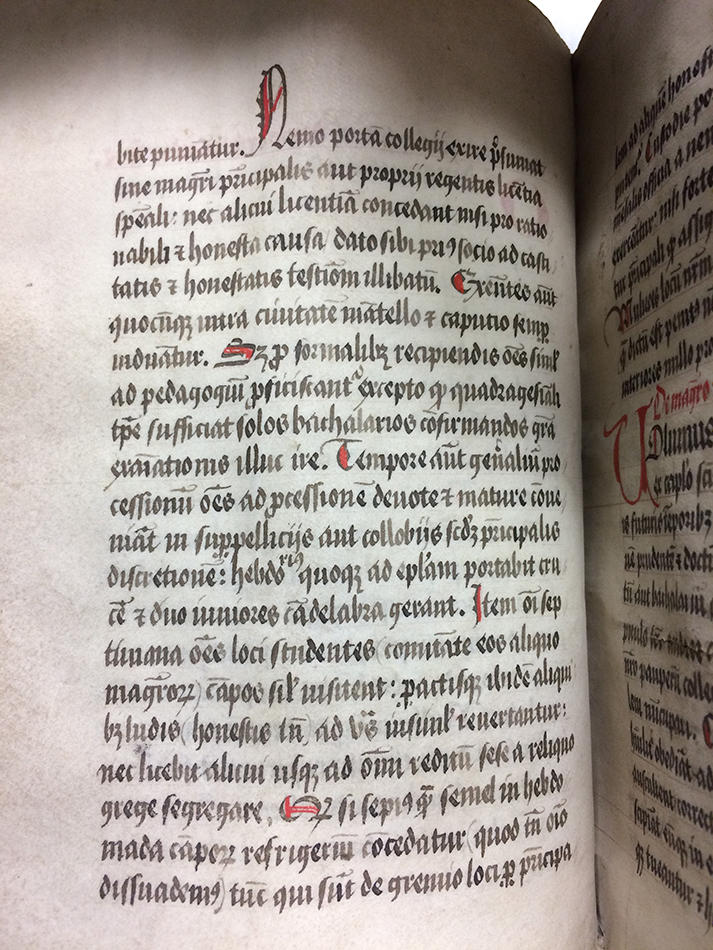
One of the early references in the university archives to St Andrews students wearing gowns is in the Statutes of St Leonard’s College, 1544. The Statutes describe the daily routine of those in the college and also regulate the behaviour of the students both inside and outside the college. One of the requirements was that students were to wear the cap and gown when going outside of the college, though there was no mention of the colour of the gown.
Exeu[n]tes aut[em] quocu[m]q[ue] intra ciuitate[m] ma[n]tello [et] caputio semp[er] indua[n]tur.
When they go anywhere in the City, let them always put on gown and hood. [1]
There is speculation that the red gown was introduced to Scottish universities by James VI. [2] The Act in Favour of the University of St Andrews, issued by James VI, 4 August 1621, states that “all masters, professors, students and founded persons within the said university shall hereafter walk in their gowns throughout all the said university” but again, no mention is made of the colour.

Perhaps the earliest reference to the red gown in use at St Andrews can be found in A Modern Account of Scotland by an English Gentleman, (republished in Early travellers in Scotland edited by P Hume Brown). In this account Thomas Kirke shares his observations of the four ancient Universities of Scotland in 1679:
the regents wear what colour’d cloaths or gowns they please, and commonly no gowns at all […] the younger students wear scarlet gowns only in term time.
In 1695 the proposals of the Commissioners, who inspected the University, recommended that the Regents or Masters were to wear black gowns and the students were to wear “red gownes that thereby vaging and vice may be discouraged”. They urged the College to “endeavour to bring the custom of wearing gowns there in Practice”.

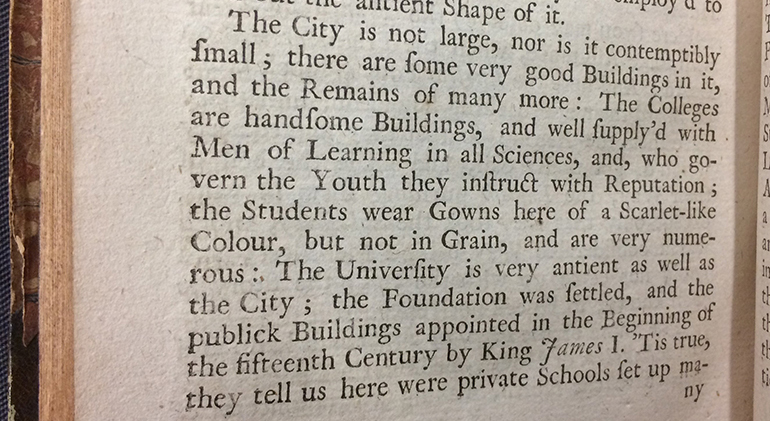
Later, Daniel Defoe in A tour thro’ the Whole Island of Great Britain in the 1720s refers to the academic dress of students in his description of the University: “the Students wear Gowns here of a Scarlet-like Colour, but not in Grain, and are very numerous”.
The red gown continued to be worn in the 19th century, though in 1838 we find students wishing that the gown be altered, perhaps for something warmer, and petitioning United College:
78 students earnestly requesting that the meeting would sanction such a form of gown as would serve at the same time as a cloak
The United College authorities granted their request, introducing sleeves and a velvet yoke.
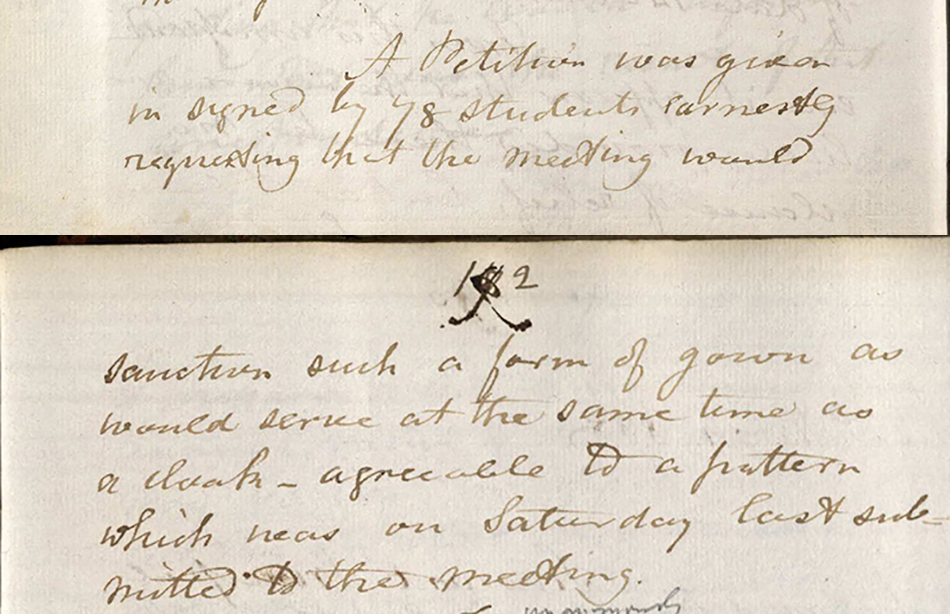
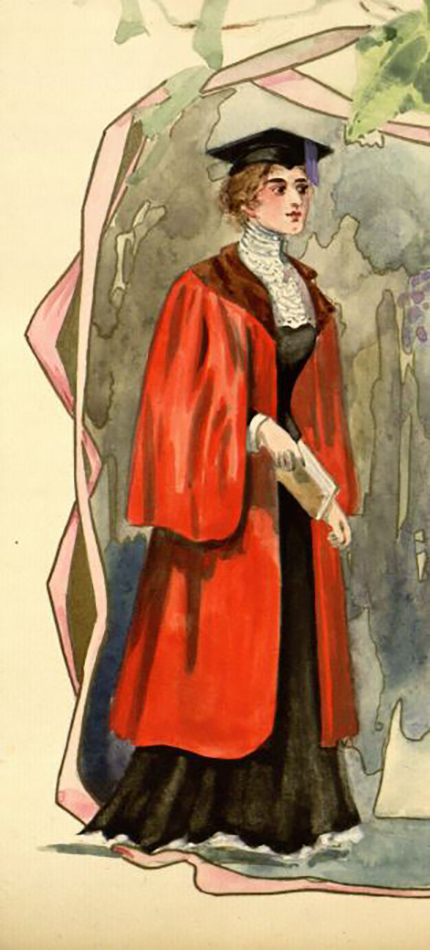
Women were admitted to the University from 1892. We see evidence of female students wearing the gown in the latter half of the 19th century in the presentation album (ms38672) made for Louisa Lumsden, Warden of University Hall on her retirement in 1900.
By the middle of the 20th century, there were fears that the red gown was falling out of use. The issue was raised by the Student Representative Council to Senatus in 1950. They asked that more should be done to encourage the wearing of the undergraduate gown and that the Deans should bring to the attention of students the regulations of the Colleges regarding wearing gowns to College classes and on academic occasions.
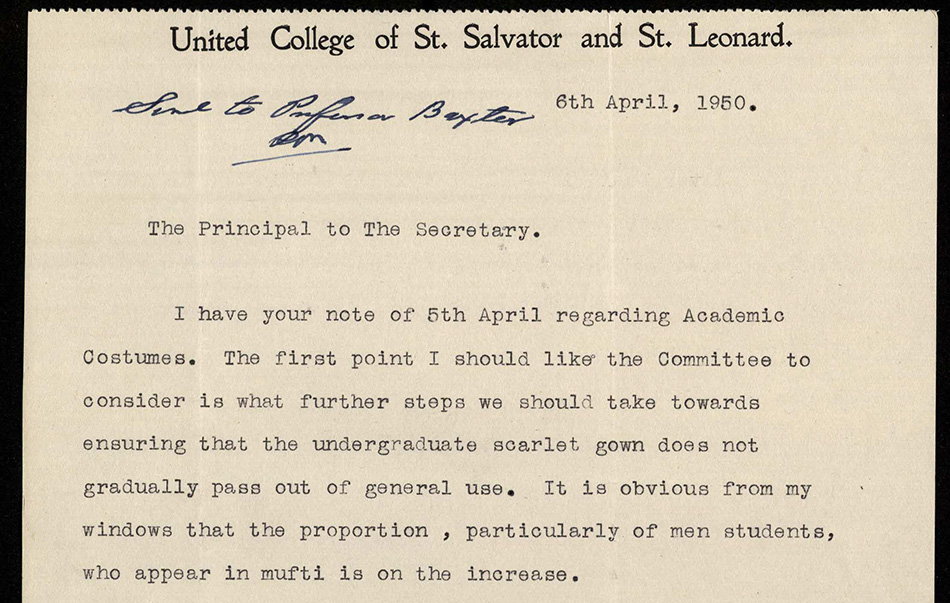
The matter was acknowledged by Principal Irvine to the secretary of the Academic Costume Committee, Professor J H Baxter and the issue was raised at the Committee meeting of the 5 May 1950:
In view of the fact that the proportion, particularly of men students, who do not wear the undergraduate scarlet gown appears to be on the increase the Committee considered what steps should be taken towards ensuring that the gown does not gradually pass out of general use.

The committee submitted a report to Senatus and it was agreed that the section on Academic Dress in the University Calendar be rewritten and the appropriate dress for undergraduates be included. The University Calendars for the academic year 1951-1952 and onwards outline the appropriate academic costume for undergraduates as “scarlet cloth, with full open sleeves half the length of the gown.” A 1963 report from the official outfitters to the University, R.W. Forsyth specified the scarlet nap for the gowns was of British Colour Council shade “Signal Red 210”.
The issue was however raised again at the end of 1966 as the Academic Costume Committee expressed their dismay at the decline in those wearing the undergraduate gown. They recommended “that the rule obliging matriculated students to wear the gown at lectures and at academic ceremonies might be expressed in stronger terms” than that already expressed in the University Calendar 1966-1967.
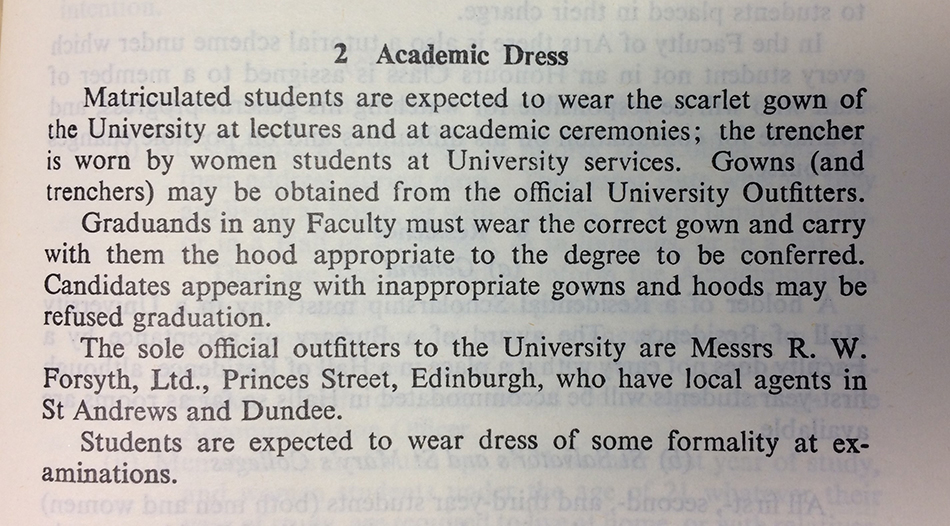
By 1973, the Academic Costume Committee reported that “although the red gown was now little in evidence at lectures, the students continued to possess gowns” and that 600 gowns were sold the previous year. In comparison, a letter from a member of staff at the University of Aberdeen around the same time (19 October 1973) reported that “the scarlet toga is now very little used here”, only by a few when dining in residences and during the collection at King’s College Chapel.
Despite the apparent decline in use, the red gown continued to be iconic for St Andrews students. In a promotional film, The Fibre Web, made for the Fife based paper making firm Tullis Russell, St Andrews students are shown on North Street in their gowns in 1964.
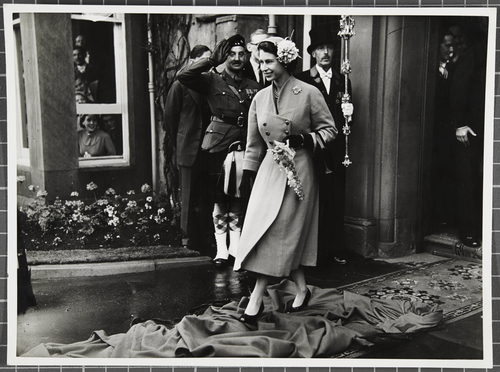
The gown over the years has been used in some creative ways. When Queen Elizabeth II was visiting Queen’s College, Dundee in June 1955, four medical students spontaneously used their gowns as a carpet for the Queen in the rain. In the news coverage of the time, the headline read ‘Students play “Raleigh” for the Queen’, referring to the myth of Sir Walter Raleigh placing his cloak over a puddle for Queen Elizabeth I.
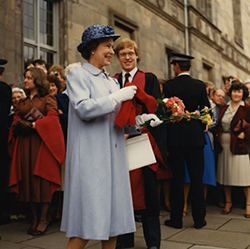
In another visit to the University in July 1982, Queen Elizabeth II was presented with a miniature red gown by John Anderson, then President of the Students Representative Council, in honour of the recent birth of Prince William, Duke of Cambridge the previous month – very far-sighted of the University community, given that he went on to wear the scarlet gown as an undergraduate.
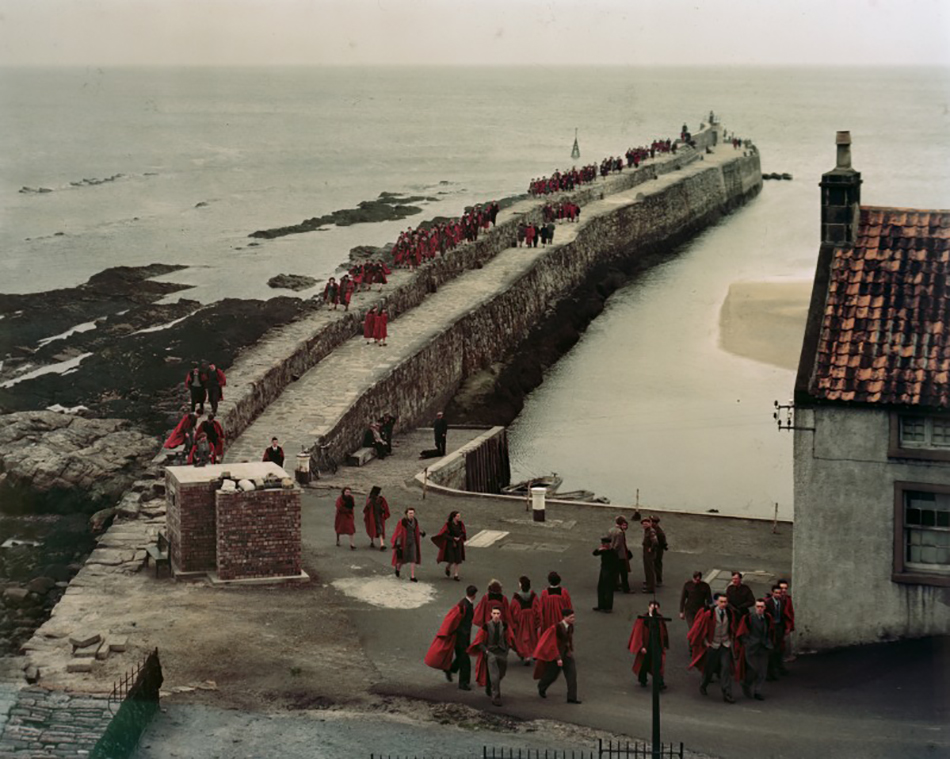
While the sight of the red gown in lectures and daily activities is less common, the gown is still worn at formal occasions and on the traditional Sunday pier walk. The manner in which the gown is worn is now a way to immediately identify what year and faculty an undergraduate is in. Divinity students of St Mary’s College wear the black undergraduate gown with a purple saltire cross. First year arts and science students (bejants) wear the gown high on their shoulders. Second years wear it lower down the shoulder, third year Arts students off of the left shoulder and third year Science students off the right shoulder. Final year students, that much closer to graduation and no longer being students, wear it low down and off both shoulders. In recent years the tradition of wearing raisin strings, which attached items representing the academic family to the gown, has fallen out of use.
To start the new academic year 2018-2019, hundreds of students took part in the traditional pier walk this past Sunday and, in continuation of the tradition, many were wearing their red academic gowns.
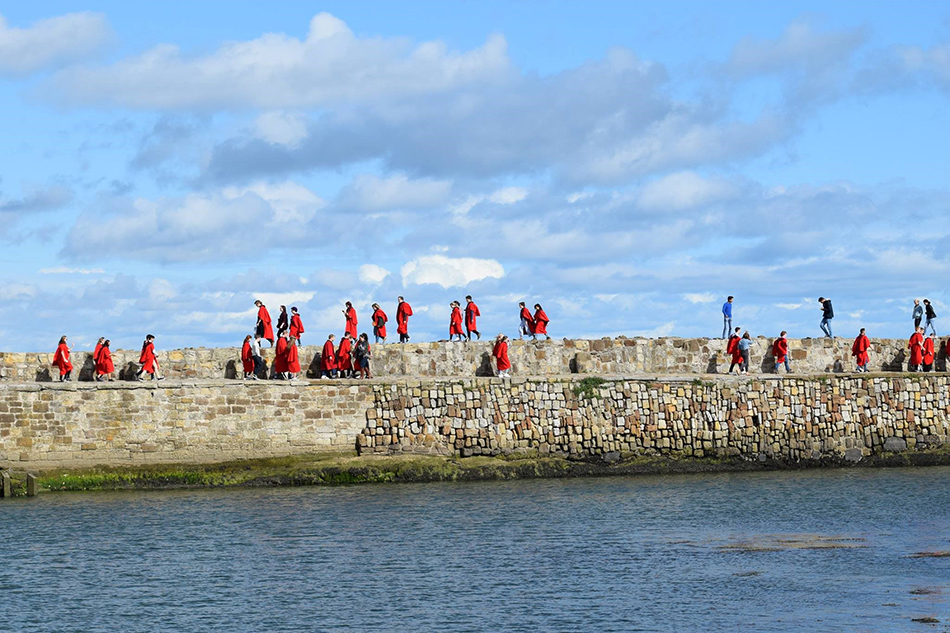
Sarah Rodriguez
Principal Archives Assistant
[1] John Herkless and Robert Kerr Hannay, The College of St. Leonard: being documents with translations, notes and historical introductions (Edinburgh, 1905), p.167
[2] Jonathan Cooper, “The Scarlet Gown: History and Development of Scottish Undergraduate Dress”, Transactions of the Burgon Society Vol. 10 (2002), p.13